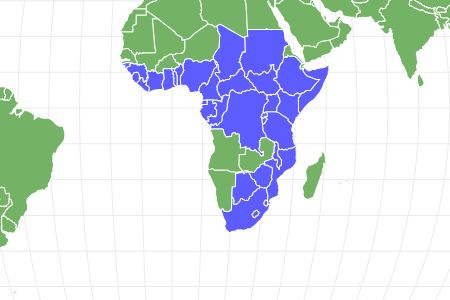Buffalo
Syncerus caffer
Very distant cousin of the American Bison.
Advertisement
Buffalo Scientific Classification
- Kingdom
- Animalia
- Phylum
- Chordata
- Class
- Mammalia
- Order
- Artiodactyla
- Family
- Bovidae
- Genus
- Syncerus
- Scientific Name
- Syncerus caffer
Read our Complete Guide to Classification of Animals.
Buffalo Conservation Status
Buffalo Facts
- Average Litter Size
- 1
- Lifestyle
- Herd
- Favorite Food
- Grass
- Type
- Mammal
- Slogan
- "They look like you owe them money."
View all of the Buffalo images!
Increasingly threatened by human development
What this lumbering African bovine lacks in style, it makes up for in substance. Not to be confused with American bison, the African Buffalo is an animal that can adapt to a wide variety of habitats, runs up to 37 miles per hour, and literally cannot be tamed. Over their roughly two-decade lifespan, they hang around in herds that “vote,” while grazing on lands that are increasingly threatened by human development.

Top Facts
The African buffalo is the largest bovine species in Africa. Except for their characteristic horns, they look like regular cattle. But these animals are not docile like most cattle–they are one of the most dangerous animals you can encounter in the wild, and they are responsible for as many as 200 human deaths per year.
With that said, here are a few other facts:
- No gentle giant: The buffalo’s ornery nature and roughly 35-mile-per-hour top speed leads to numerous injuries and deaths yearly, earning it the nickname “black death.” Learn about the strongest animals in the world here.
- Who’s the boss?: The base of the male buffalo’s unique, curving horns grows to meet at the top of its head, forming a kind of helmet called a “boss.”
- Herd mentality: Buffalo herds use a kind of “vote” to decide which direction to move next!
- Distant family: Though all members of the family bovinae, “buffaloes” are only from Africa and should not be confused with the American Bison or water “buffaloes!”
You can check out more incredible facts about buffalos.
Scientific Name
The scientific name for the African Buffalo is Syncerous Caffer. “Syncerous” is greek, meaning “top together,” a reference to the large horn bases on the male buffalo that appear joined on the top of the head. “Caffer” comes from the Latin “Country of the Kaffirs,” a reference to Africa as a whole.
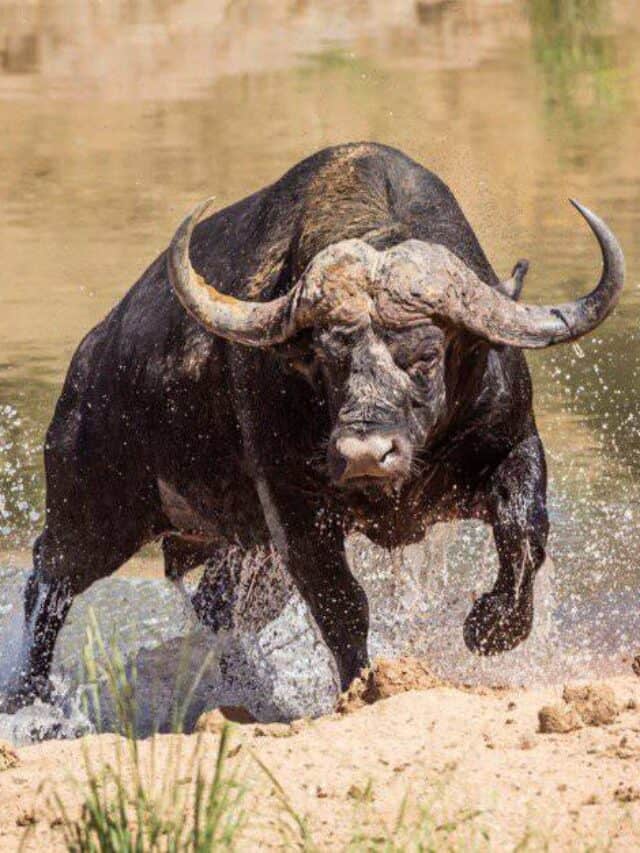
Cape buffalo, despite weighing as much as a ton, can race up to 40 mph, jump up to 6 feet vertically and can quickly pivot to combat predators.
©PACO COMO/Shutterstock.com
Evolution
Scientific research has shown that there were two main lineages of the African buffalo existent 100,000 years ago–the Cape Buffalo and the African forest buffalo. There is also evidence of the subspecies for West African and Central African subspecies evolving 10,000 years ago. African buffalo have a smaller ancestor they evolved from that migrated into Africa between 5 to 6 million years ago.
Types of Buffalo
There are four subspecies of African buffalos listed below:
- African Forest Buffalo (Syncerus caffer nanus) – Located in forests of Central and West Africa; smallest subspecies of African buffalo; also called dwarf buffalo or the Congo buffalo; red in color.
- Cape Buffalo (Syncerus caffer caffer) – Located in Southern and East Africa; largest subspecies of African buffalo.
- West African Savanna Buffalo (Syncerus caffer brachyceros) – Also called Sudan buffalo; mid-sized subspecies; lives in savannas and floodplains of parts of West Africa.
- Central African Savanna Buffalo (Syncerus caffer aequinoctialis) – Lighter in color than other subspecies; sometimes called Nile buffalo; lives in savannas and floodplains of Central and East Africa.
- Mountain Buffalo (Syncerus caffer mathewsi) – Also called the Virunga buffalo; inhabits the mountains of Rwanda, Uganda, and Democratic Republic of Congo.
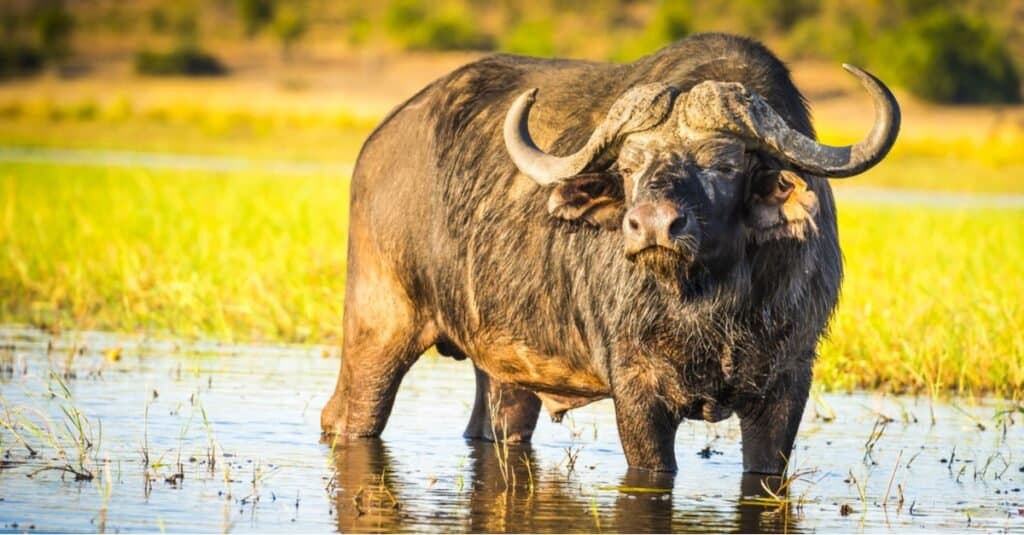
The Cape buffalo is the largest subspecies of African buffalo.
©THP Creative/Shutterstock.com
Appearance and Behavior
All African buffalo are large and cattle-like animals, though they don’t share a close genetic link to cattle. The males average 1,600 pounds as adults–about as big as a four-wheeler! They also stand about five feet tall at the shoulder and reach as long as seven feet from nose to tail. Despite their size, a charging buffalo can reach up to 37 miles per hour.
African buffalo also have a terrible reputation for being ornery. Estimates vary, but deadly attacks by cape buffalo have earned it the nickname “black death.” In one infamous case, an experienced South Africa-based hunting guide was killed by a buffalo–a member of the same herd as a buffalo the guide, himself, had just shot. For this reason, trophy hunters have listed the African buffalo as one of the top five most dangerous (and, therefore, prized) creatures to hunt.
Despite this reputation, research has also found herds of African buffalo to be somewhat democratic and altruistic. Herd movements, for example, undergo a kind of a “vote” where females lay in the direction they want to move, with the most popular direction becoming the one the herd moves next. Herds will also band together to protect calves from attacks. They’ll even look out for other adults in the herd.
African buffaloes come in four varieties. These include the cape, West Africa savanna, Central Africa savanna and forest buffalo, and are mostly distinguished by their horn shape and relative size. The most common are the Cape buffalos, with a dark-brown coating of short, coarse fur and large, distinctive horns that curl downward and back up, similar to a ram. Savanna buffalo are similar to Cape buffalo, but with slightly shorter horns and a wide range of fur styles ranging from light brown to virtual black. Forest buffalo are generally smaller than the others, with lighter brown (or even reddish) fur and shorter horns. Younger savanna buffalo sometimes have light brown fur as well, but most forest buffalo keep theirs into adulthood.
Buffaloes are animals that congregate in large herds, with each herd featuring anywhere from 50 to 500 members. Sometimes herds will join to create temporary super-herds, numbering in the thousands, to keep lions and other predators from easily singling out single members to attack. Any herd is typically made up of females and their calves.
Males will periodically form “bachelor groups,” smaller herds of adult males only. Even these herds, however, will separate into younger males and older males. The oldest males tend to prefer solitude.
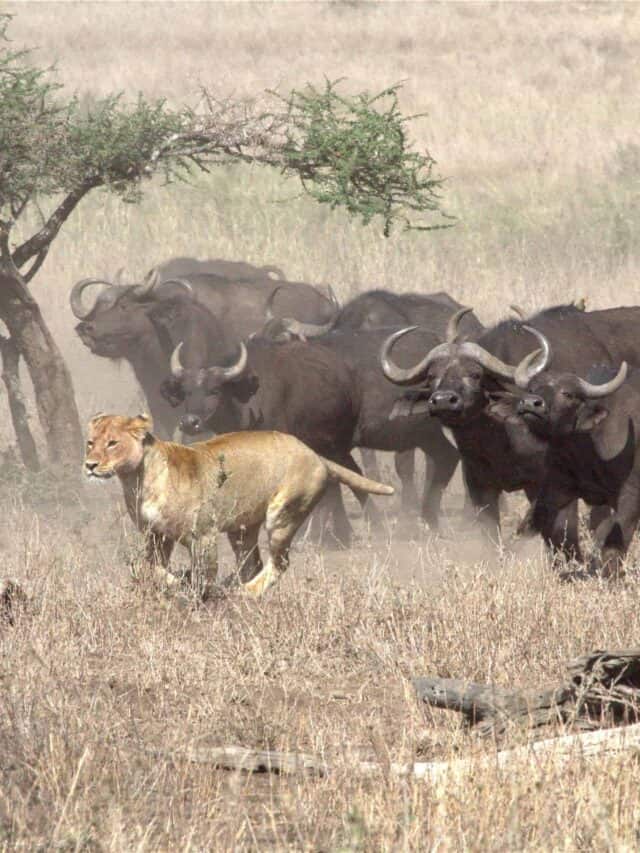
African buffalo typically congregate in herds fro 50 to 500.
©iStock.com/Mark Haeussler
Relationship to other “buffaloes”
Despite similar names, African buffaloes are not the same as “buffaloes” in other parts of the world. These include the water buffalo in Asia and the American bison, often called a “buffalo.” It only takes a close look to see how much different bison are from buffaloes–American bison have smaller, differently-shaped horns, thicker fur (often with a “beard!”), a hump at the shoulders and a completely different head shape.
Water buffalo, meanwhile, share a number of other features, but have some big differences. Unlike their African cousins, water buffalo are largely domesticated. This means they are used, specifically throughout China and India, similar to how cows and oxen are used in other parts of the world. Though African buffalo are sometimes hunted for meat, their unpredictable attitude has prevented them from ever being tamed. Almost all water buffaloes in the world are tamed, and virtually all African buffaloes are wild.
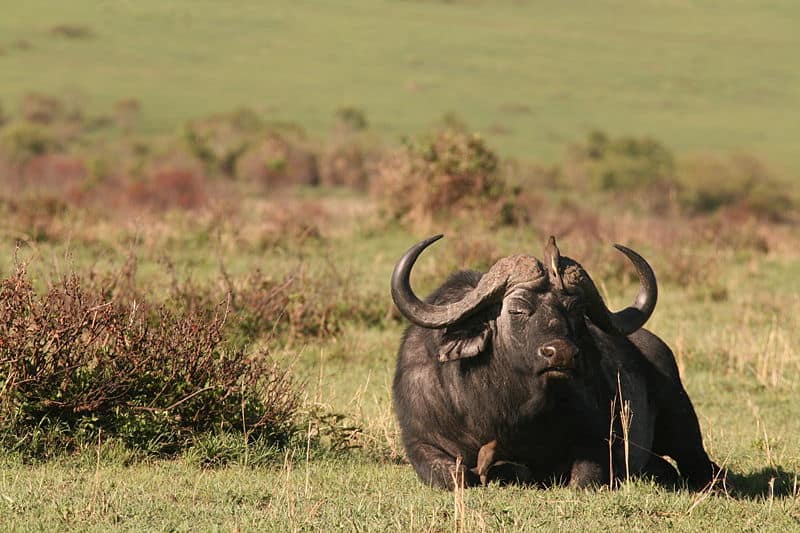
The African Buffalo has never been domesticated due to its unpredictable nature.
Habitat
African buffalo can survive almost anywhere there is water. This includes swamps, semi-arid brushland and forests. They live throughout the continent of Africa, particularly central and southern Africa. Countries include Sierra Leone, Ghana, Cameroon, Kenya, Central African Republic, South Africa, Botswana and more.
Diet
Despite their sometimes violent nature, buffaloes don’t eat meat. Like many hooved animals, they spend their waking moments grazing on plants. Though they only have a very distant evolutionary link to cows and other bovines, buffalo will chew cud just like a cow. That means, they will spit up grass from earlier to re-chew and extract more nutrients.
Unlike other grazing animals, African buffalo graze mostly at night. They appear to do this, in part, because buffalo have a hard time regulating their body temperature.
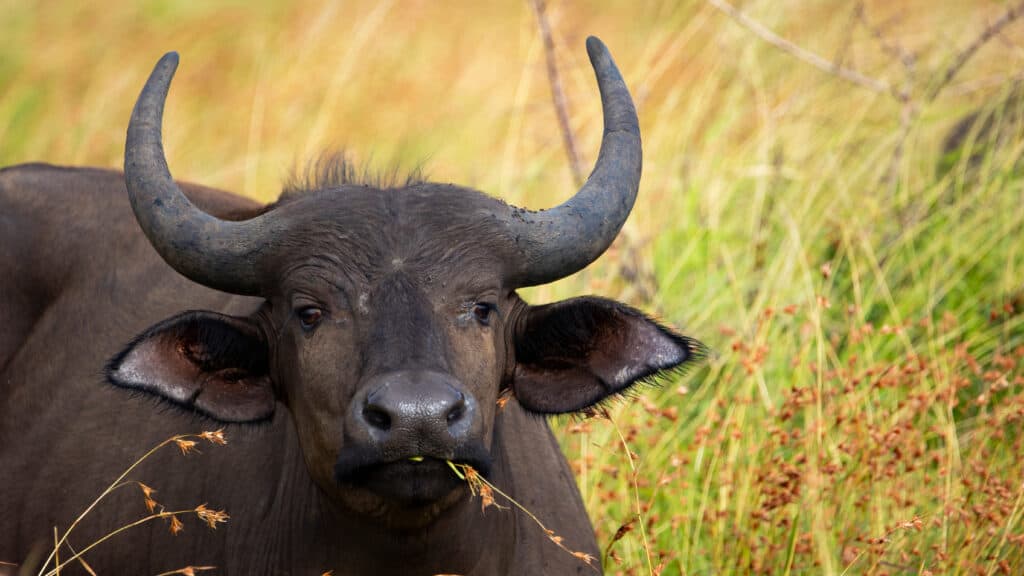
African buffalo most often graze at night partially because they struggle to regulate their body temperature.
©Jurgens Potgieter/Shutterstock.com
Predators and Threats
Though buffalo face a number of predators in the wild, their biggest threats are humans and food sources. Buffalo spend most of their day grazing, making them susceptible to starvation during droughts. Meanwhile, their prized status by hunters means there’s no shortage of big game safaris that target them. Africa’s natural hunters–particularly, lions and packs of wild dogs–pose a constant threat to buffalo that get separated from the herd.
The biggest threat to African buffalo, however, is irresponsible human development. Development, such as carving out cropland or clearing fields for housing and city expansion, cuts up the habitats of the buffalo, making it harder to find food. Since buffalo spend most of their day eating, this can quickly affect populations. It can also put humans at danger from buffalo, as buffalo tear up crops, knock down fences, and spread disease to livestock.
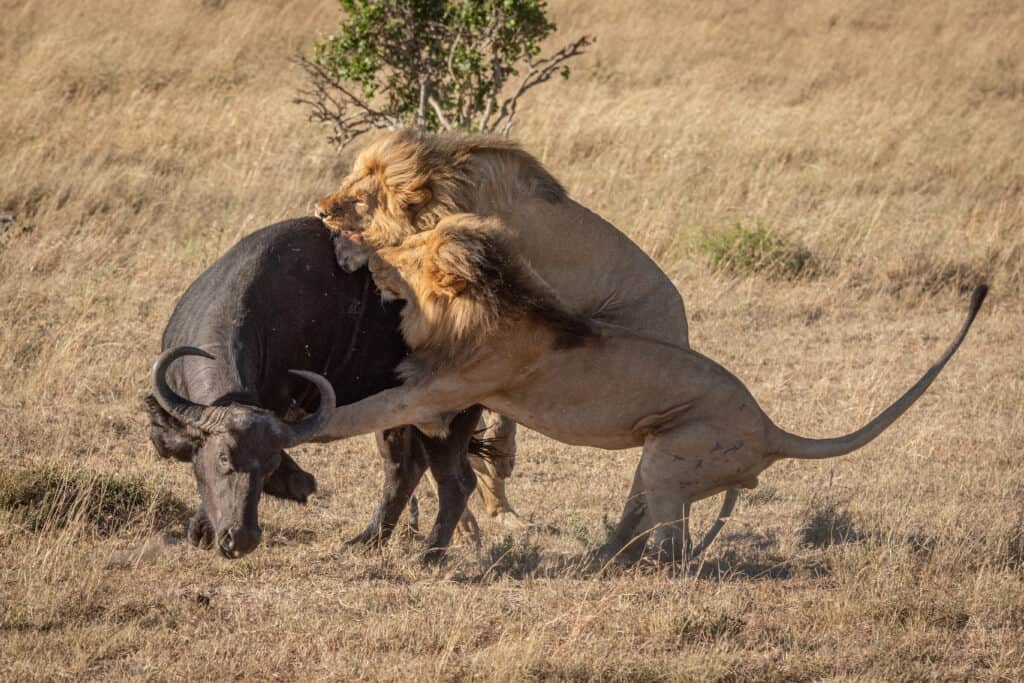
Lions are one of the natural predators of African buffalo.
©nwdph/Shutterstock.com
Reproduction, Babies, and Lifespan
The African buffalo gives birth to approximately one calf every few years. Mothers remain pregnant for as much as a full year–longer than humans, even! After giving birth, the calf will remain dependent on the mother for as much as another year. Though male buffalo will take no direct role in upbringing, the calves emit a specific cry that will bring all members of the herd to their rescue.
After birth, calves take another four to five years to reach maturity. After maturing, females will typically remain with the herd where they were born, while males will leave for one of the “bachelor” herds. Females will typically begin having offspring around this time.
In the wild, buffaloes typically live for 10-22 years, while living almost 30 years in captivity.

African Buffalo ten to live 10-22 years in the wild and up to 30 years in captivity.
Population
Buffaloes enjoy a healthy population throughout Africa, but numbers are declining. In the last decade, the International Union for the Conservation of Animals (IUCN) has changed the buffalo’s status from “Least Concern” to “Near Threatened.” This decline is attributed to farming practices that destroy their grazing lands, as well as threats from prize hunters and meat poachers.
View all 285 animals that start with BBuffalo FAQs (Frequently Asked Questions)
Are African Buffalo a species of American Buffalo?
They are not. The American Buffalo is actually a “bison.” In taxonomy, African buffalo and bison come from two distinct evolutionary paths, connected only by the same subfamily that also includes antelope, yaks and cattle.
Are buffalo used for meat or milk, like other livestock?
African buffalo do not end up on farms. Though they share many features with other types of livestock, their unique temperament has made them impossible to tame. Some will poach the buffalo for meat, but this is a dangerous task for even the most experienced hunters.
Are Buffalo herbivores, carnivores, or omnivores?
Buffalo are Herbivores, meaning they eat plants.
What Kingdom do Buffalo belong to?
Buffalo belong to the Kingdom Animalia.
What phylum do Buffalo belong to?
Buffalo belong to the phylum Chordata.
What class do Buffalo belong to?
Buffalo belong to the class Mammalia.
What family do Buffalo belong to?
Buffalo belong to the family Bovidae.
What order do Buffalo belong to?
Buffalo belong to the order Artiodactyla.
What genus do Buffalo belong to?
Buffalo belong to the genus Syncerus.
What type of covering do Buffalo have?
Buffalo are covered in Hair.
In what type of habitat do Buffalo live?
Buffalo live in woodland and grass pastures.
What are some distinguishing features of Buffalo?
Buffalo have shoulder humps and large, curved horns.
What do Buffalo eat?
Buffalo eat grass, shrubs, and leaves.
What are some predators of Buffalo?
Predators of Buffalo include humans, lions, and crocodiles.
What is the average litter size for a Buffalo?
The average litter size for a Buffalo is 1.
What is an interesting fact about Buffalo?
Buffalo have no real natural predators!
What is the scientific name for the Buffalo?
The scientific name for the Buffalo is Syncerus Caffer.
What is the lifespan of a Buffalo?
Buffalo can live for 15 to 22 years.
How fast is a Buffalo?
A Buffalo can travel at speeds of up to 22 miles per hour.
What are the differences between a buffalo and a wildebeest?
The greatest differences between a buffalo and a wildebeest include their morphology, behavior, and location.
Buffaloes are large, partially migratory ungulates with a brown, black, or reddish color and large horns that form a boss on the animals’ heads from most of sub-Saharan Africa. Wildebeests are smaller ungulates with gray or brown hair and stripes in some cases with a shaggy mane and a head carried above the shoulders that live in migratory herds in the southern third of Africa.
What are the differences between a buffalo and a beefalo?
The main difference between beefalo and a buffalo is that beefalo is a hybrid between cattle and buffalo, while buffalo is a species of bovid that are native to the Americas.
How to say Buffalo in ...
Thank you for reading! Have some feedback for us? Contact the AZ Animals editorial team.
Sources
- David Burnie, Dorling Kindersley (2011) Animal, The Definitive Visual Guide To The World's Wildlife
- Tom Jackson, Lorenz Books (2007) The World Encyclopedia Of Animals
- David Burnie, Kingfisher (2011) The Kingfisher Animal Encyclopedia
- Richard Mackay, University of California Press (2009) The Atlas Of Endangered Species
- David Burnie, Dorling Kindersley (2008) Illustrated Encyclopedia Of Animals
- Dorling Kindersley (2006) Dorling Kindersley Encyclopedia Of Animals
- David W. Macdonald, Oxford University Press (2010) The Encyclopedia Of Mammals

